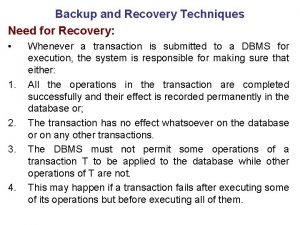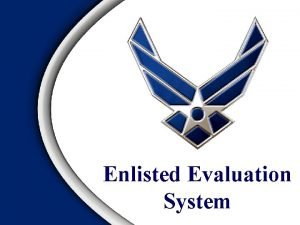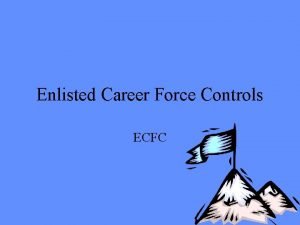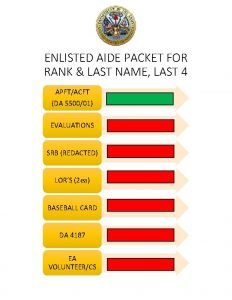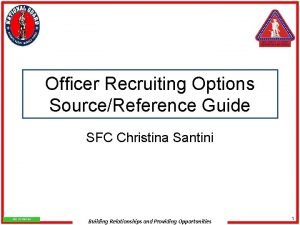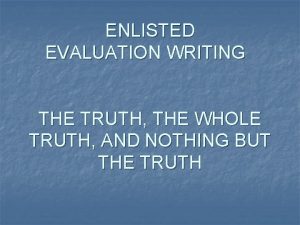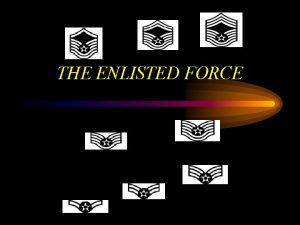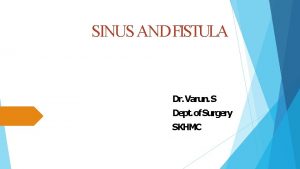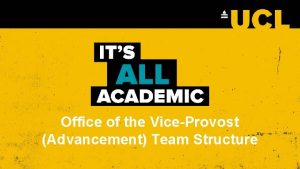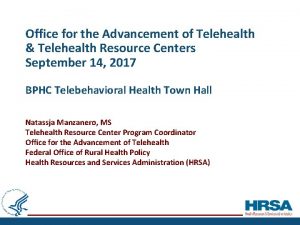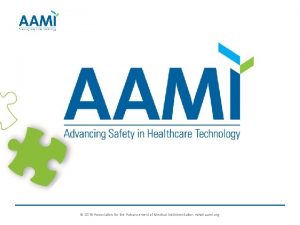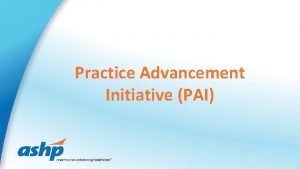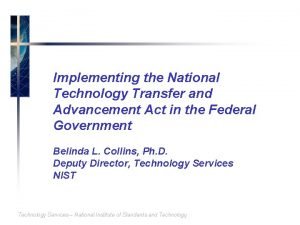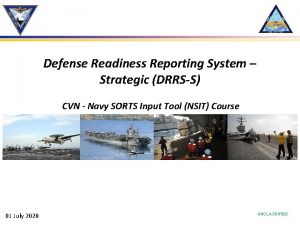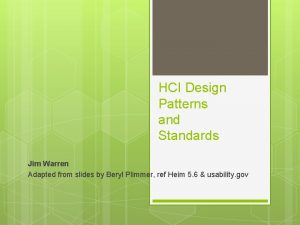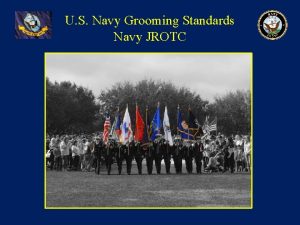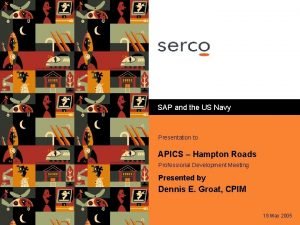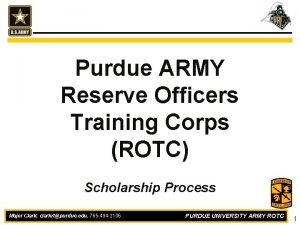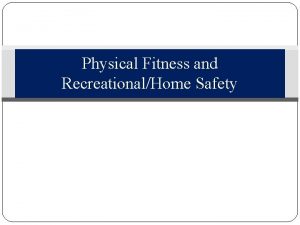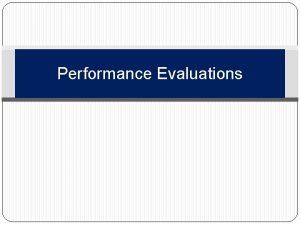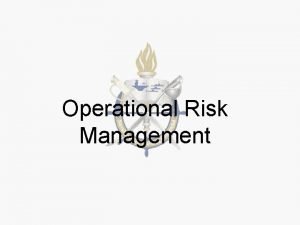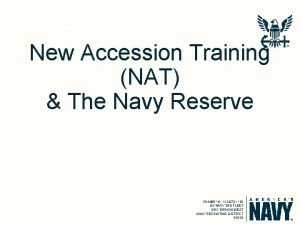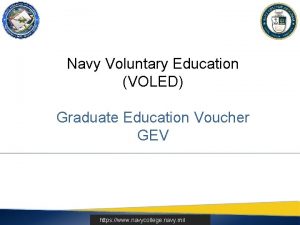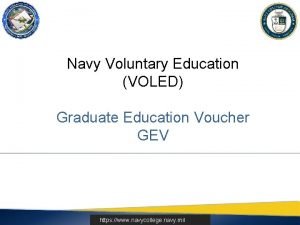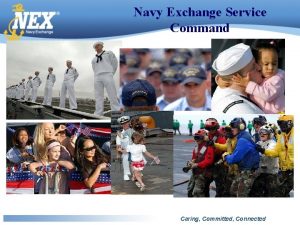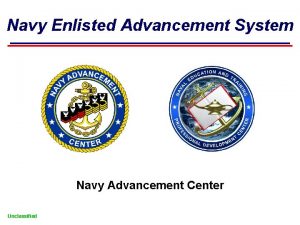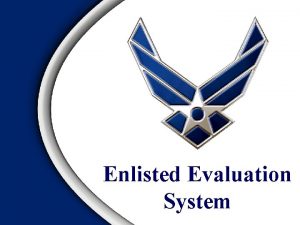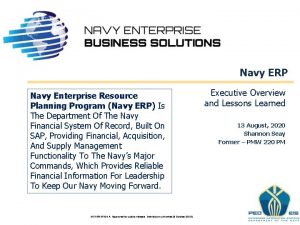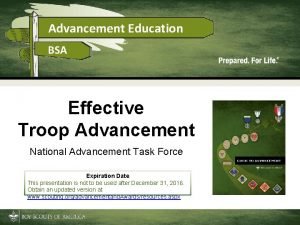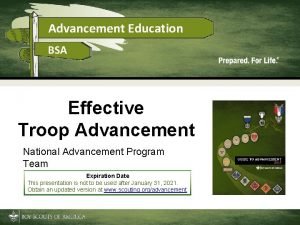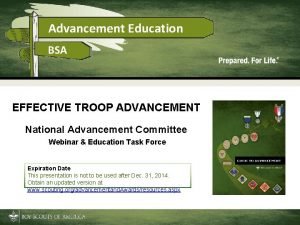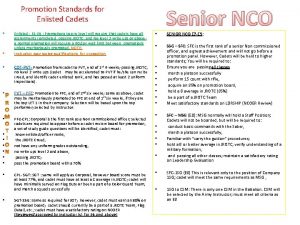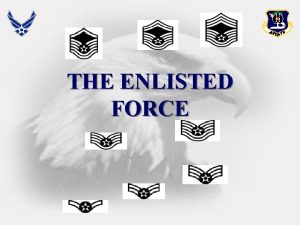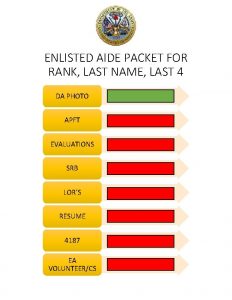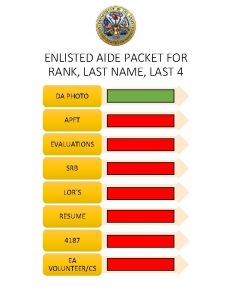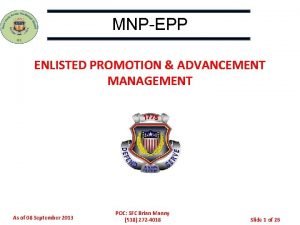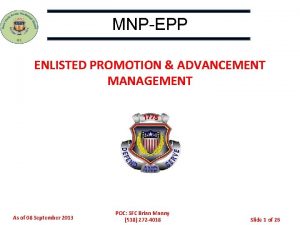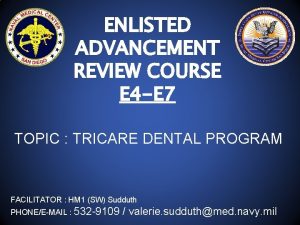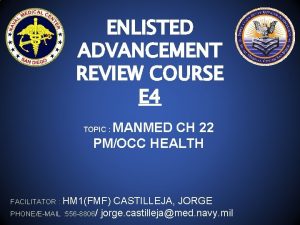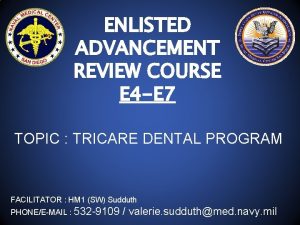Navy Enlisted Advancement System NEAS Last update May













































- Slides: 45

Navy Enlisted Advancement System (NEAS) Last update: May 2007 3 February 2003 Navy Advancement Center 1

Presentation Topics u Purpose u Exams u Final development and administration Multiple Score Factors u Profile u What of advancement exams sheet - What does it mean? you should do to prepare for advancement u Recent and future changes 3 February 2003 Navy Advancement Center 2

Questions u What five factors make up the Final Multiple Score (FMS) for E-4 to E-6 candidates? u Is the FMS different for E-7 candidates? u What percentage of E-7 candidates are selected to be board eligible? u What factor has the largest percentage of the FMS for E-4 to E-6 candidates? u What number of occupational & PMK questions are on each exam? 3 February 2003 Navy Advancement Center 3

Purpose of Advancement Examinations The advancement-in-rate examination is a tool used, as part of the Final Multiple Score, to help rank order qualified candidates on the basis of rating and professional military knowledge at the next higher rate. 3 February 2003 Navy Advancement Center 4

Qualifying to Take the Exam u CO recommendation u Meet minimum time in rate (TIR) requirement u Proper Path of Advancement u Requirements u must be met for STRIKERS/GENDETS - Meet minimum requirements for rating (i. e. citizenship, security clearance, and training) u - Counseled by their Career Development Team (CDT) after the CREO/REGA message is released (about 60 days prior to exam) u - Must receive approval by the ECM, if required by the CREO/REGA message, prior to the date of examination. 3 February 2003 Navy Advancement Center 5

Exam Development Facts u Written by CPOs (E-7 to E-9) – NETPDTC hosts an Advancement Exam Development Conference for each rating on a 2 year cycle. At least 6 Fleet SMEs from the respective rating are invited to attend. – Recent fleet experience – From ratings (BM, SH, etc. ) or – From rating communities (EMN, AWA, etc. ) u Advancement exams are designed to test rating and professional military experience and knowledge 3 February 2003 Navy Advancement Center 6

Exam Development Facts u Exams consist of 200 questions Occupational + E 7 E 6 E 5 E 4 3 February 2003 100 115 135 150 Professional Military Knowledge (PMK) 100 85 65 50 Navy Advancement Center 7

More Exam Development Facts u Advancement exams test on occupational (rate) and professional military knowledge (PMK) information – Exams test the most important topics for the rate – Every question must be supported by a reference – Occupational Standards, Naval Standards, or Competencies pertaining to the rating are used to validate questions 3 February 2003 Navy Advancement Center 8

Advancement Exam Development Conference u 1. 2. 3. 4. 5. EVERY ONE TO TWO YEARS Review Scope of the Rating Verify Master Reference List Update, edit, and improve exam banks and graphics Build 14 examinations (2 years) Post new Advancement Exam Strategy Guide (AESG) 3 February 2003 Navy Advancement Center 9

Exam Scoring u Approaches to exam scoring: – Criterion-referenced (schoolhouses) – Norm-referenced (Navy advancement exams) 3 February 2003 Navy Advancement Center 10

Standard Score Example Raw Score 0 100 Standard Score 3 February 2003 200 u Raw score: 0 to 200 u Raw scores are converted to standard scores u Standard score: 20 to 80 u Average of all raw scores is assigned standard score 50 Navy Advancement Center 11

Myth u MYTH: Scoring the maximum 80 points on the exams means you “aced” the exam. u FACT: It simply means you performed better than all or almost all of the other candidates taking the same exam. FACT: 80 “represents” the highest standard score attained for a group of candidates taking the same examination (the best raw score may have been a 175). 3 February 2003 Navy Advancement Center 12 u

Final Multiple Score (FMS) The Final Multiple Score (FMS) method looks at the “whole person” u u E-4/5/6 – Performance – Experience ( service in paygrade, awards, and PNA points) – Exam Score (standard score) E-7 – Performance – Exam Score (standard score) 3 February 2003 Navy Advancement Center 13

Old FMS Chart 3 February 2003 Navy Advancement Center 14

Contribution to Variance FMS Factors (E-6 USN/R) 3 February 2003 Navy Advancement Center Note: FMS formula change at Cycle 155; FMS formula change at Cycle 168. 15

Changes for August/September 2007 u Increase Performance Mark Average (PMA) u Reduce Service in Paygrade and Pass Not Advanced Factors by One Half – Maintain experience (SIPG) at a reduced number of factor points – Maintain sustained superior performance (PNA) at a reduced number of factor points CURRENT FMS E-4/5 MAX ELEMENT u. Performance Mark Average PTS % INCREASE PMA and HALF SIPG & PNA E-6 MAX PTS % E-4/5 MAX PTS % E-6 MAX DELTA PTS % DELTA 84 36% 110 41. 5% 90 43% 7% 116 48. 5% 7% 80 34% 80 30% 80 38% 4% 80 33. 5% 30 13% 34 13% 15 7% -6% 17 7% -6% 30 13% 30 11% 15 7% -6% 15 6% -5% 10 4% 12 4. 5% 10 5% 1% 12 5% 0. 5% 234 100% 266 100% 210 100% 240 100% (Performance/CO’s Recommendation) u. Standard u. Service Score (Knowledge) in Paygrade (Career Rating Experience) u. Pass Not Advanced Points (Sustained Superior Performance) u. Awards u. Total (Experience/Performance) Points u Note: E-7 FMS does not change from current FMS 3 February 2003 Navy Advancement Center 16

New FMS Chart u Note: E-7 FMS does not change from current FMS 3 February 2003 Navy Advancement Center 17

Changes (Cont’d) u Change in PMA Formula: – from current: (12 pt difference between EP & MP or MP & P) v v E-4/5 = (PMA x 60) - 156 E-6 = (PMA x 60) – 130 – to new: (16 pt difference between EP & MP or MP & P) v E-4/5 = (PMA x 80) - 230 v E-6 = (PMA x 80) – 204 3 February 2003 Navy Advancement Center 18

FMS for E-7 Candidates (Maximum possible points) u u Examination standard score: 80 60% Performance: 52 40% 132 100% Total Possible 3 February 2003 Navy Advancement Center 19

Study Results • Rank ordering from Mar 06 rating exams • Note differences in rank ordering for Sailors with high PMA • Most Sailors with high PMA increased in ranking compared to the current ranking 3 February 2003 Navy Advancement Center 20

Rankings for SH 1 3 February 2003 Navy Advancement Center 340 CANDIDATES 37 SELECTEES (9 Candidates W/ 4. 0 PMA not shown) 21

Performance Mark Average (PMA) Representation of a Typical E-6 Candidate PMA Frequency Distribution u Promotion recommendation point values Early Promote Must Promote Promotable Progressing Significant Problems u Time-in-rate PMA based on: 3 yrs of averaged evals for E-6 1 yr of averaged evals for E-4/5 3 February 2003 E-3 to E-4 to E-5 to E-6 to E-7 Navy Advancement Center = = = 4. 00 3. 80 3. 60 3. 40 2. 00 requirements 6 mos in E-3 12 mos in E-4 36 mos in E-5 36 mos in E-6 22

How is PMA calculated? Example for PO 2 participating in PO 1 exam: Evaluation ending 02 March 15 01 March 15 00 March 15 Block 45 mark EP = 4. 00 MP = 3. 80 Add 4. 00 + 3. 80 = 11. 6, divide by 3 = 3. 866 Round up to 3. 87 Final PMA is 3. 87 3 February 2003 Navy Advancement Center 23

Performance Mark Average Contribution to Final Multiple Score Performance Mark Average 4. 00 3. 80 3. 60 3. 40 FMS Points E 4/5 E 6 E 7 90. 0 74. 0 58. 0 42. 0 116. 0 100. 0 84. 0 68. 0 52. 0 49. 4 46. 8 44. 2 *These values are based on individual’s average over the cumulative reporting periods. 3 February 2003 Navy Advancement Center 24

Passed Not Advanced (PNA) Points Representation of a Typical E-6 Candidate PNA Frequency Distribution • Sustained Superior Performance • Awarded to those who pass the exam but are not advanced due to quota limitations • Points awarded each exam cycle based on combination of Performance Mark Average (PMA) and Exam Standard Score (SS) • Up to 3. 0 PNA points awarded per exam cycle up to 5 cycles (1. 5 points max each for PMA and SS) u. PMA (max 1. 5 points per cycle) awarded based on ranking relative to peers: Top 25% = 1. 5 PNA Points Next 25% = 1. 0 PNA Points Next 25% = 0. 5 PNA Points Bottom 25% = 0 PNA Points • SS (max 1. 5 points per cycle) awarded based on exam score: 57. 01 - 80. 00 = 1. 5 PNA points 50. 01 - 57. 00 = 1. 0 PNA points 42. 01 - 50. 00 = 0. 5 PNA points < 42. 01 = 0 PNA points • Maximum total weight 7% (E-4/E-5); 6% (E-6) Rarely maxed to 15 Pts 3 February 2003 Navy Advancement Center 25

Awards (AWD) Points Representation of a Typical E-6 Candidate AWD Frequency Distribution • Experience / Performance • Not proposed for reduction / elimination • Points awarded as per chart below • Maximum point awarded 10 (E 4/E 5) 12 (E 6) • Maximum total weight 5% (E 4/E 5/E 6) AWARD Rarely maxed to 10 Pts for E-4/5 3 February 2003 Navy PTS/AWDS Medal of Honor 10 Navy Cross 5 Distinguished Service Medal or Cross 4 Silver Star Medal 4 Legion of Merit 4 Distinguished Flying Cross 4 Navy and Marine Corps Medal 3 Bronze Star Medal 3 Purple Heart 3 Defense Meritorious Service Medal 3 Joint Service Commendation Medal 3 Navy and Marine Corps Commendation Medal 3 Executive Letter of Commendation 2 Joint Service Achievement Medal 2 Navy and Marine Corps Achievement Medal 2 Combat Action Ribbon 2 Gold Life Saving Medal 2 Good Conduct Medal (Navy or Marine Corps) 2 Naval Reserve Meritorious Service Medal 2 Individual Augmentee (IA) Tour 2 Air Medal (Strike/Flight) 1 Advancement. Letter Center of Commendation (Flag/Senior Executive Service) 261

Service in Paygrade (SIPG) Representation of a Typical E-6 Candidate SIPG Frequency Distribution • Rating Experience • Up to 7. 5 years awarded (E 4/E 5/E 6) • Maximum total weight 7% (E 4/E 5/E 6) SIPG (YYMM) Rarely maxed to 7. 5 yrs at E-4/5 NOTE: At 2003 E-6, candidates can get a. Navy 1 year. Advancement EP waiver. 3 February Center 27

Maximum Factor Counts and Highest FMS 3 February 2003 Navy Advancement Center NOTE: Inval and Change of Rate Candidates are not included in Total Candidate count. 28

Now, let’s talk about the Profile Information Sheet… 3 February 2003 Navy Advancement Center 29

Final Multiple Score Breakdown PNA Point Breakdown Exam Score by Section Breakdown 3 February 2003 Navy Advancement Center 30

Initial Profile Sheet 3 February 2003 Navy Advancement Center 31

Post Board Profile Sheet 3 February 2003 Navy Advancement Center 32

Questions and Answers u QUESTION: What if a reference is revised so that it changes the correct answer to an exam question? u ANSWER: – If the change makes the question’s original correct answer no longer valid or no longer the ONLY correct answer, the question will be deleted. – If the change results in a different answer than the original correct answer, then answer key is simply changed to reflect the new correct answer. 3 February 2003 Navy Advancement Center 33

…another Q & A u QUESTION: I missed making rate by less than 1 point. What should I do? u ANSWER: Contact PSD/ESO to make sure all possible FMS points were submitted 3 February 2003 Navy Advancement Center 34

“Where do the advancement quotas originate? ” 3 February 2003 Navy Advancement Center 35

“What do you mean, there was a discrepancy on my test? ” https: //www. advancement. cnet. navy. mil/nac/exams/discrepancy. asp u Discrepancies: u. Examples: u Errors can lead to: – An error on a worksheet – Missing or incorrect PMA – Delayed results or advancements – An error on an answer sheet – Improper processing Or – information that does not match the Enlisted Master File – Overwriting bar-coded information with incorrect answer sheet bubbling – Improper path of advancement – LOSING OUT ON ADVANCEMENT – Not meeting special rating requirements – Incorrect SSN – Name on Answer Sheet not matching EMF – Insufficient Time-in-Rate 3 February 2003 – Recording exam rate incorrectly (MM vice MMN entered on answer Navy Advancement Center sheet) 36

“How can YOU help YOUR Sailors to be prepared for Advancement? ” u Make sure they meet all eligibility requirements u Make sure they understand sustained superior performance is the key u Provide useful guidance in their evaluations and mid-term counseling u Ensure they know about the tools to help them succeed (Bibliography, References, AESG, schools, OJT, etc. ) u Use the Advancement Exam Strategy Guide (AESG) to help focus their study plan. u START EARLY--don’t wait until the last minute! 3 February 2003 Navy Advancement Center 37

Bibliography for Advancement Study (Bibs) u Bibs are available ONLY in electronic form – available at https: //www. advancement. cnet. navy. mil u Bibs list the source references for each rating exam u Always study the most recent version of any reference! u The Advancement Exam Strategy Guide (AESG) for each rating links the references used in advancement exams to the Topic and Subtopics tested 3 February 2003 Navy Advancement Center 38

Advancement Exam Strategy Guide 3 February 2003 Navy Advancement Center 39

Bibliography Web Posting For Advancement Exams u ACTIVE DUTY BIBS EXAM CYCLE JANUARY MARCH SEPTEMBER u E-7 EXAM E-4/5/6 EXAM POST DATE JULY OCTOBER APRIL RESERVES BIBS EXAM CYCLE POST DATE FEBRUARYE-7 EXAM AUGUST FEBRUARYE-4/5/6 EXAM SEPTEMBER AUGUST E-4/5/6 EXAM MARCH 3 February 2003 Navy Advancement Center 40

Exam Schedule January 3 rd Thursday E 7 February (Reserve) March E 4/5/6/7 1 st Thursday E 6 2 nd Thursday E 5 3 rd Thursday E 4 August (Reserve) E 4/5/6 September 1 st Thursday E 6 2 nd Thursday E 5 3 rd Thursday E 4 3 February 2003 Navy Advancement Center 41

Recent Changes to Enlisted Advancement u Effective Mar 2007 - Two advancement points (the same as for receipt of Navy Achievement Medal) will be awarded to Sailors who successfully complete a tour greater than 90 consecutive days in a designated combat zone (CENTCOM, Iraq, Afghanistan, and HOA, etc) u Effective 2007 – IAs serving designated combat areas will have a 4 -month windows in which to take an exam (2 months prior and 1 month after) u Effective Feb 2007 – IAs serving in designated combat areas TIR eligible for E-7 will be validated for the CPO board without having to take the advancement exam. This is a one-time policy. 3 February 2003 Navy Advancement Center 42

Summary u Purpose of advancement exams u Exams development and administration u Final Multiple Score Factors u Profile sheet - What does it mean? u What you should do to prepare for advancement u Recent and future changes 3 February 2003 Navy Advancement Center 43

u For general NEAS information or to download information: – Home page: https: //www. advancement. cnet. navy. mil – Specific questions: v Command Master Chief – EMCM(SS) Robert Mc. Combs – DSN 922 -1305 or 922 -1572 – COMM: (850) 452 -1305 or 922 -1572 Exam Development: Kirk Schultz DSN: 922 -1001, ext 2141 COMM: (850) 452 -1001, ext 2141 Exam Administration: – Jim Hawthorne – DSN 922 -1001, ext 1531 – COMM: (850) 452 -1001, ext 1531 v Exam discrepancies: – DSN: 922 -1252 – 2003 COMM: (850) 452 -1252 3 February Navy Advancement Center 44

3 February 2003 Navy Advancement Center 45
 Backup and recovery techniques
Backup and recovery techniques Enlisted evaluation system
Enlisted evaluation system Aecp guidelines 2022
Aecp guidelines 2022 Ecfc usmc
Ecfc usmc Enlisted aide packet
Enlisted aide packet Enlisted signature block
Enlisted signature block Navy eval closing statements early promote
Navy eval closing statements early promote Enlisted force structure powerpoint
Enlisted force structure powerpoint Enlisted association of tennessee
Enlisted association of tennessee Stages of tb lymphadenitis
Stages of tb lymphadenitis Center for the advancement of science in space
Center for the advancement of science in space Patella baja
Patella baja Advancement office structure
Advancement office structure Office for the advancement of telehealth
Office for the advancement of telehealth Holistic advancement meaning
Holistic advancement meaning Holistic advancement meaning
Holistic advancement meaning Uf advancement
Uf advancement Advancement in medicine
Advancement in medicine High and low vowels are classified according to
High and low vowels are classified according to Professional advancement in nursing
Professional advancement in nursing Fistulectomy
Fistulectomy Dental hygienist advancement opportunities
Dental hygienist advancement opportunities Association for the advancement of medical instrumentation
Association for the advancement of medical instrumentation Ge center for additive technology advancement
Ge center for additive technology advancement Scoutbook advancement sync
Scoutbook advancement sync Practice advancement initiative
Practice advancement initiative National technology transfer and advancement act
National technology transfer and advancement act Daf yomi advancement forum
Daf yomi advancement forum State bank of india canada
State bank of india canada Pctef
Pctef Hci patterns
Hci patterns Deadly force triangle
Deadly force triangle New navy pt uniform
New navy pt uniform Distributed energy storage
Distributed energy storage Jrotc female hairstyles
Jrotc female hairstyles Navy sap training
Navy sap training Purdue trustees scholarship
Purdue trustees scholarship Navy male prt standards
Navy male prt standards Brag sheet example navy
Brag sheet example navy 5 step orm
5 step orm Navy reserve regions
Navy reserve regions Graduate education voucher
Graduate education voucher Graduate education voucher
Graduate education voucher Articles of the code of conduct
Articles of the code of conduct Navy international programs office
Navy international programs office Navy exchange flyer
Navy exchange flyer
